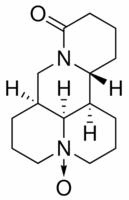All AbMole products are for research use only, cannot be used for human consumption.

Oxymatrine has been shown to exhibit anti‑inflammatory, antiviral, and anticancer properties. Oxymatrine significantly inhibited the proliferation of prostate cancer cells in a time‑ and dose‑dependent manner. Oxymatrine treatment may induce prostate cancer cell apoptosis in a dose‑dependent manner. In vivo analysis demonstrated that oxymatrine inhibited tumor growth following subcutaneous inoculation of prostate cancer cells into nude mice. Oxymatrine exerts anti-inflammatory properties in LPS-stimulated macrophages by down-regulating the TLR4/NF-κB pathway. Oxymatrine effectively suppressed the phosphorylation of EGFR (Tyr845), and EGFR was the target of oxymatrine. Oxymatrine could be a strong immunomodulator, influence TLR9 signaling transduction, and synergistically improve the immune efficacy of the TLR9 ligand against CHB.
| Molecular Weight | 264.37 |
| Formula | C15H24N2O2 |
| CAS Number | 16837-52-8 |
| Solubility (25°C) | DMSO 53mg/ml Water 53mg/ml Ethanol 53mg/ml |
| Storage |
Powder -20°C 3 years ; 4°C 2 years In solvent -80°C 6 months ; -20°C 1 month |
| Related Products |
|---|
| DSPE-PEG-FA
DSPE-PEG2K-FA is a PEG derivative containing folic acid. DSPE-PEG2K-FA has a targeting effect and can bind to folic acid receptors in cancer cells. DSPE-PEG2K-FA forms micelles/lipid bilayers and can be used in research on targeted drug delivery systems. |
| Lifastuzumab
Lifastuzumab is a humanized anti-NaPi2b IgG1 monoclonal antibody. |
| GPVI antagonist 1
GPVI antagonist 1 is a glycoprotein VI (GPVI) platelet receptor antagonist. GPVI antagonist 1 inhibits collagen-induced platelet aggregation with an IC50 of 25.3 μM. |
| MPSD TFA
MPSD TFA (MARCKS-ED TFA) is a 25-amino acid peptide based on the effector domain sequence of the intracellular membrane protein myristoylated alanine-rich C-kinase substrate (MARCKS). MPSD TFA can sense membrane curvature and recognize phosphatidylserine. MPSD TFA can be utilized as biological probe to study membrane shape and lipid composition. |
| 4-Nitro-2,1,3-benzoselenadiazole
4-Nitro-2,1,3-benzoselenadiazole is a biochemical material that can be used in scientific research. |
All AbMole products are for research use only, cannot be used for human consumption or veterinary use. We do not provide products or services to individuals. Please comply with the intended use and do not use AbMole products for any other purpose.


Products are for research use only. Not for human use. We do not sell to patients.
© Copyright 2010-2024 AbMole BioScience. All Rights Reserved.
